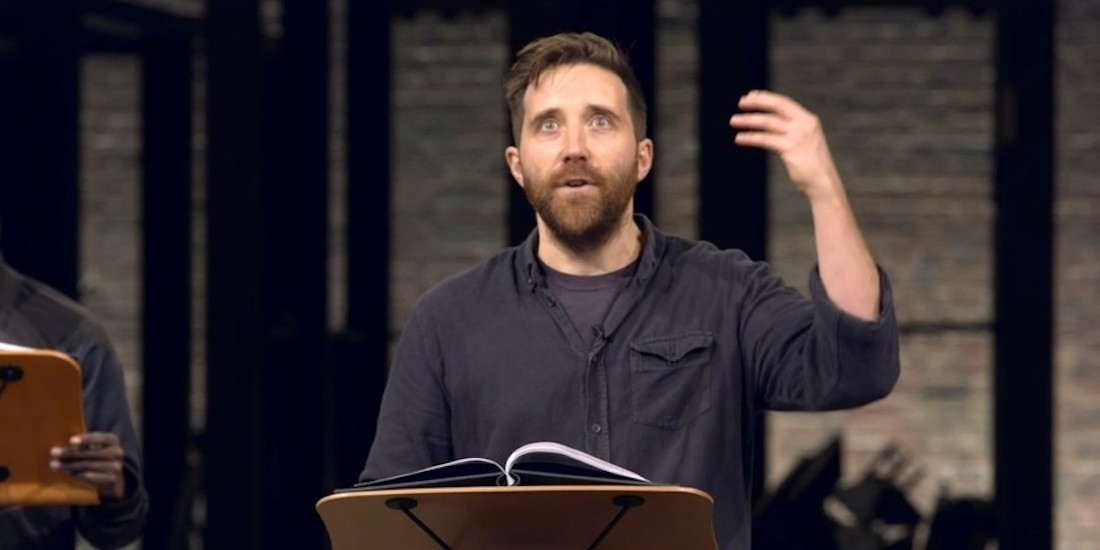As part of its winter season, and conceived very much with Covid restrictions in mind, THE RSC has adapted the most famous eighteenth-century English translations of Homer’s ‘Iliad’ and ‘Odyssey’ for an all-day dramatized reading with the title ‘Troy Story’. There are five segments taking the action from the rivalry between Achilles and Hector through to the fall of Troy and the trials of Ulysses/Odysseus on his journey home to Ithaca. Each episode deploys five actors – with some overlap of personnel between segments – and the action is framed and interrupted at points by two musicians – a singer and an oud/guitar player. There are no sets or costumes or staging beyond the static but expressive movements of the individual actors.
Given the absence of formal staging, the expressive weight of the day rests on the text, and what the actors do with it. Here there are specific challenges to overcome. Dryden and Pope chose to translate Homer within the conventions of eighteenth-century classicism which means that the text is presented in ‘heroic’ rhyming couplets. To present this form on a stage rather than for private reading in a book requires great skill on the part of the actors if the monotony of delivery is to be avoided. It can be done, and to very good effect; but it requires a willingness to embrace the formal constraints of the verse first before finding room for creative expression within it. Not all the actors in Gregory Doran’s production rise to these challenges.
This is particularly a problem in the first two segments devoted to the wrath – or better sulk – of Achilles, the death of his friend/lover Patroclus at the hands of Hector, and finally the terrible vengeance of Achilles ending in his ritual humiliation of Hector’s corpse. For much of these opening episodes, the language is that of stately set-piece description, and with a lack of visual action on stage, the audience is thrown back on what the actors can do with the language. Unfortunately, many of them resort to a generalized, exaggerated shouting that seems self-conscious, at least in front of the camera. Less is more, as so often. The eloquent adjective-heavy language does much of the work for you, if it is correctly pointed, and if notice is taken of the varieties in the verse forms, such as the pauses in the midst of lines, and the lessons of punctuation.
Things improve markedly in parts three and four, devoted to the Fall of Troy and two of the trials of Ulysses on his wayward journey home to Ithaca. These sections are more narrative-driven anyway, less declamatory, and contain more interplay of character and incident. But they are also populated by actors with more confidence and skill in dealing with the formal obstacles in their path.
Leading the way is Joseph Kloska, who brings to the role of Aeneas all the narrator’s variety of tone and timbre that he learned in ‘Imperium’ a couple of years ago. The energy levels and dramatic tensions go up markedly (and with that the number of quite natural textual fumbles) once he and his colleagues get stuck into Troy’s final demise and his family’s escape. Amanda Hadingue, Greg Haiste, and Georgia Landers in particular bring their characters to life, as the wooden horse hoves into view and brings about the city’s destruction.
Likewise, in the stories of the Cyclops and the Sirens, the actors work comfortably with the medium to bring to life both the pastoral idyll and gory horrors of the first, and the sinister beauty of the second. Jonathan Broadbent distils out of his wealth of Shakespearean experience a portrait of Ulysses that is truly multi-layered – both cheekily humorous, wily, and slippery; and it is a genuinely inspired move to have actors using sign language to bring to visual life the grim threats of Scylla and Charybdis. It was a reminder of how much we were missing the element of visual variety.
And so you end the day with mixed feelings. At its best, you begin to understand clearly why Dr. Johnson regarded Pope’s translations of Homer as the most accomplished done in English, and you appreciate how their dramatic potential has so far gone largely unharnessed. It was an excellent idea to have these texts taken out of respectable leather-bound volumes and put to work. But in its present form, the overall result is patchy in execution. If it returns in some shape or form post-Covid, then perhaps some tweaks and recasting may provide more sustained verbal enjoyment and greater visual variety and incident too.

